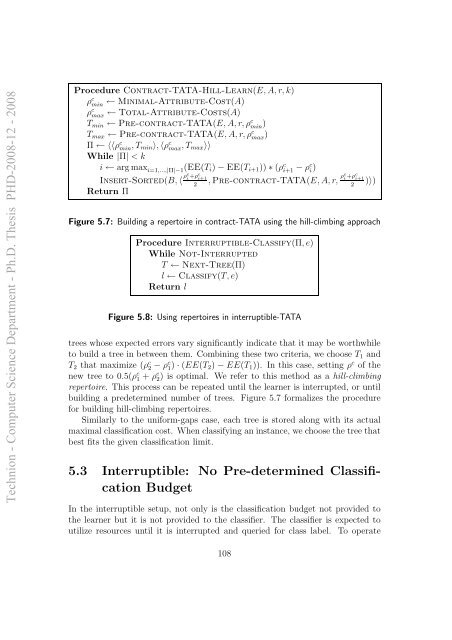anytime algorithms for learning anytime classifiers saher ... - Technion
anytime algorithms for learning anytime classifiers saher ... - Technion
anytime algorithms for learning anytime classifiers saher ... - Technion
Create successful ePaper yourself
Turn your PDF publications into a flip-book with our unique Google optimized e-Paper software.
<strong>Technion</strong> - Computer Science Department - Ph.D. Thesis PHD-2008-12 - 2008<br />
Procedure Contract-TATA-Hill-Learn(E, A, r, k)<br />
ρc min ← Minimal-Attribute-Cost(A)<br />
ρc max ← Total-Attribute-Costs(A)<br />
Tmin ← Pre-contract-TATA(E, A, r, ρc min )<br />
Tmax ← Pre-contract-TATA(E, A, r, ρc max )<br />
Π ← 〈〈ρc min, Tmin〉, 〈ρc max, Tmax〉〉<br />
While |Π| < k<br />
i ← arg maxi=1,...,|Π|−1(EE(Ti) − EE(Ti+1)) ∗ (ρc i+1 − ρc i )<br />
Insert-Sorted(B, 〈 ρc i +ρc i+1,Pre-contract-TATA(E,<br />
A, r, 2 ρc i +ρc i+1<br />
Return Π<br />
2 )〉)<br />
Figure 5.7: Building a repertoire in contract-TATA using the hill-climbing approach<br />
Procedure Interruptible-Classify(Π, e)<br />
While Not-Interrupted<br />
T ← Next-Tree(Π)<br />
l ← Classify(T, e)<br />
Return l<br />
Figure 5.8: Using repertoires in interruptible-TATA<br />
trees whose expected errors vary significantly indicate that it may be worthwhile<br />
to build a tree in between them. Combining these two criteria, we choose T1 and<br />
T2 that maximize (ρ c 2 − ρc 1 ) · (EE(T2) − EE(T1)). In this case, setting ρ c of the<br />
new tree to 0.5(ρ c 1 + ρ c 2) is optimal. We refer to this method as a hill-climbing<br />
repertoire. This process can be repeated until the learner is interrupted, or until<br />
building a predetermined number of trees. Figure 5.7 <strong>for</strong>malizes the procedure<br />
<strong>for</strong> building hill-climbing repertoires.<br />
Similarly to the uni<strong>for</strong>m-gaps case, each tree is stored along with its actual<br />
maximal classification cost. When classifying an instance, we choose the tree that<br />
best fits the given classification limit.<br />
5.3 Interruptible: No Pre-determined Classification<br />
Budget<br />
In the interruptible setup, not only is the classification budget not provided to<br />
the learner but it is not provided to the classifier. The classifier is expected to<br />
utilize resources until it is interrupted and queried <strong>for</strong> class label. To operate<br />
108











